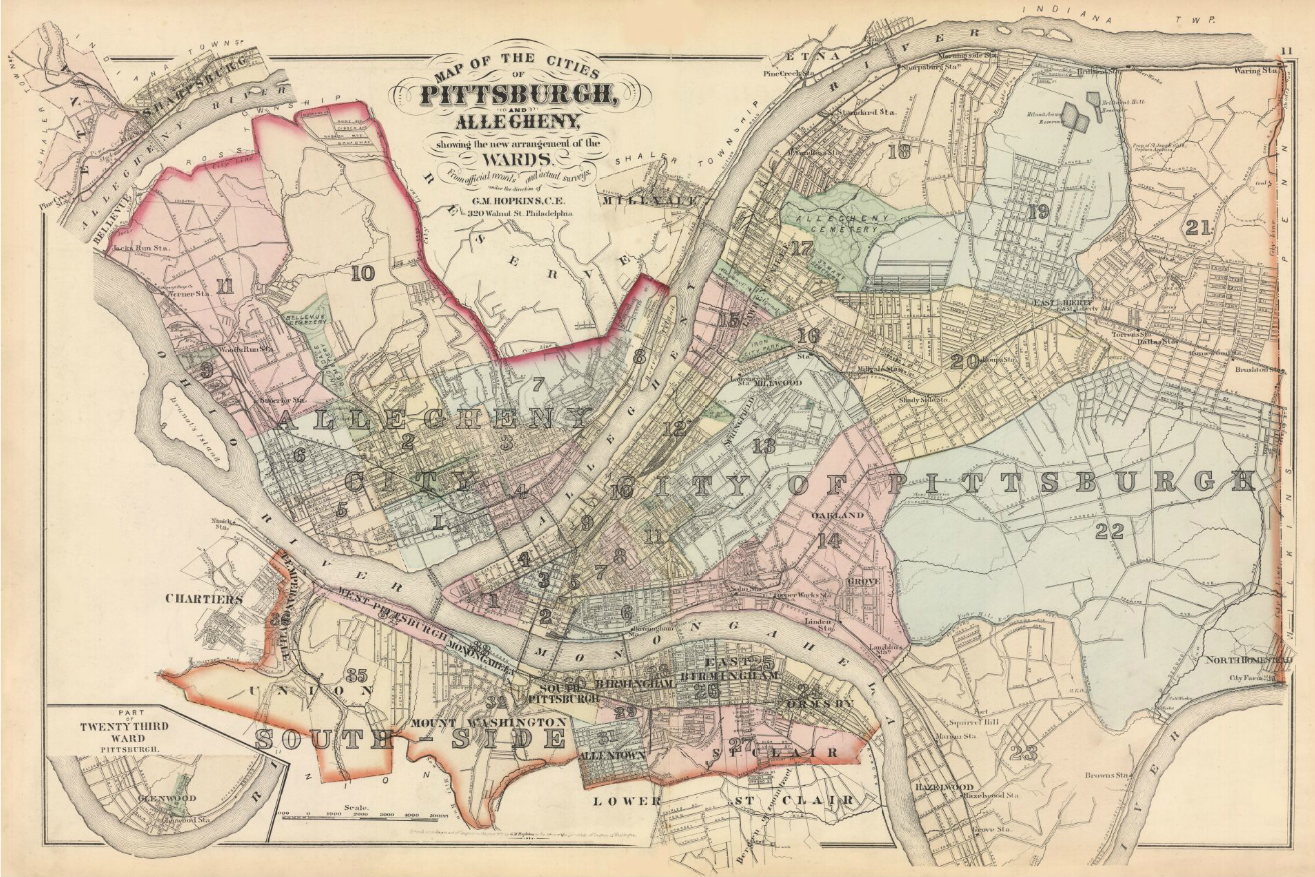‘Complicated’: Series discusses meaning behind place names


A map of the cities of Pittsburgh and Allegheny from 1872 showing the new arrangement of wards.
Ruth Mostern, an associate professor of history and director at the World History Center, said we can start to look at the world differently once we start recognizing the meaning behind place names — the labels that we give to specific locations that are meaningingful to us.
“When you start thinking about the world in that way, it’s mind-blowing to really zero in on the implications of it, because one of the ways of telling a story about history and telling stories about personal meaning is where the place is,” Mostern said. “Place names seem like they are so permanent, but they’re really not.”
Mostern explored these topics at the “What’s in a Name?: An Introduction to Place Names” lecture on Tuesday in the Global Hub at Posvar Hall. Students, faculty, staff and visitors attended the event in person as well as virtually on Zoom and YouTube.
The World History Center and Center for Latin American Studies co-sponsored the lecture as a part of the “What’s in a Name?” series. This series hosted by the Global Hub began in Spring 2021, and focuses on name identity, diversity and inclusion. So far workshops have explored topics such as name bias, microaggressions in names and LGBTQ+ name experience.
Mostern said places are often only thought about in a physical way, such as names of buildings, because we use them for navigation. But Mostern argued that any locale on earth that’s meaningful to somebody is considered a place.
“It might be much more complicated than what we tend to think,” Mostern said. “Most of what we think of a place isn’t about maps at all, it’s about the meaning of the place and what occurs there. Place names reflect some version of networks and relationships. Place is not about geography and place is not about names. Places are spatial settings for human activity.”
(Renee Dubaich | Staff Writer )
There are places such as buildings, monuments and streets on Pitt’s campus that students may see and talk about in their day-to-day lives without thinking about the historical implications, according to Mostern.
For example, the name of the Public Health building changed in 2018. The building used to be named Parran Hall, after Dr. Thomas Parran, a former Pitt dean who presided over the Tuskegee and Guatemala syphilis experiments during his time as U.S. surgeon general. Mostern said the experiments left Black men to die with syphilis even when there were treatments available.
“So anyone who went into that building was entering the space, and saying the name of this horrific racist scientist,” Mostern said.
Mostern also said many street names on Pitt’s campus are named after historical figures that contributed to violent acts against Indigenous people.
“Forbes, Braddock, so many of the major streets in the City are named after people whose history is about dispossession and violence to Indigenous people,” Mostern said.
Mostern said another example of a place name in Pittsburgh with a complicated history is Bouquet Street.
“General Bouquet in the British Colonial Army was the person who was responsible in organizing the tactic of giving smallpox-infected blankets to Indigenous people. He is literally someone who engaged in genocide,” Mostern said. “And yet we don’t think about them when we talk about Bouquet Street.”
In her presentation, Mostern gave an example to unsettle the notion of what place is to most people — the covered Christopher Columbus statue next to Phipps Conservatory. The statue was covered in 2020 after controversy over his legacy in committing acts of violence against inigenous people.
“It is now wrapped in plastic. It’s no longer the site of a Columbus statue. The plaque and name removed has been removed,” Mostern said. “It is now the site of a tented entity.”
Karen Lue, Global Hub director and co-organizer of the series, said the topics discussed in these lectures are tough because they can be very personal.
“These are topics that are really worth exploring. I think it can bring us more together as a community and help us be more aware of the people in the places that we are interacting with,” Lue said. “Especially, it brings together a University where there are students, faculty, staff and visitors coming from all over the world.”
Mostern is also the director of the World Historical Gazetteer project, a resource implementing tools of the digital humanities to reflect the sense of history and experience when thinking about place names. According to Mostern, the term “gazetteer” represents any kind of structured list of place names. Mostern said the platform currently has two million modern place names as well as 60,000 historical place names.
“It is intended to provide a platform and content and core infrastructure to allow all of these names to coexist, and to showcase the idea that a place doesn’t have to just have one name,” Mostern said.
Mersades Cook, a first-year master’s student in international development, said she decided to attend the event after hearing about the gazetteer project in her class.
“Professor Mostern talked to us about the gazetteer project in class before, and I found it really interesting and I wanted to learn more and see more about that,” Cook said.
Keila Grinberg, a professor in the Center for Latin American Studies, also spoke at the event. She focused on the 1600 Angolian slave market and how the Baixa de Cassanje revolt influenced the name of a beach in Latin America. Cassange, a popular beach in Salvador, is a term associated with enslavement, but also resistance, according to Grinberg.
“By investigating the association of a name to a place, we can know a lot about the story of the resistance to colonialism and enslavement,” Grinberg said.
Yue Geng, a first-year graduate student in administration and policy in education, attended the event and said she found this perspective of place names to be interesting.
“I found lots of new interesting information like how one name could mean different things to different people, that was really helpful,” Geng said.
Mostern said we should start thinking about place names as being a gateway into imagining a better future and a way of telling stories that honor different kinds of people.
“Anytime you can take names and surface what they really are, you are doing something political. You are offering the opportunity or the invitation to a community of people to say what else could this be? What happens if the world doesn’t have to be that way?” Mostern said. “All political change is about imagining future possibilities.”
Recent Posts
‘He’s off to a much faster and better start’: Republicans reflect the second Trump administration’s first two months
Since Inauguration Day Trump’s second term has caused division amongst young Americans. Despite these controversies,…
Who Asked? // Why do we accept bad treatment from people?
This installment of Who Asked? by staff writer Brynn Murawski attempts to untangle the complicated…
What, Like It’s Hard? // Lean on your people
Contributing editor Livia LaMarca talks about leaning on your support networks and gives advice on…
Note to Self // Hot Girl Summer
In the sixth edition of Note to Self, Morgan Arlia talks about how she is…
A Good Hill to Die On // Down to Date and Time
In the latest version of “A Good Hill to Die On,” staff writer Sierra O’Neil…
‘Dress for Success: Closet to Career’ alleviates the stress of building a professional wardrobe
As the end of the spring semester rapidly approaches, many Pitt students find themselves in…

